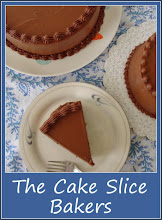 The June Daring Bakers' challenge was hosted by Jasmine of Confessions of a Cardamom Addict and Annemarie of Ambrosia and Nectar. They chose a Traditional (UK) Bakewell Tart... er... pudding that was inspired by a rich baking history dating back to the 1800's in England.
The June Daring Bakers' challenge was hosted by Jasmine of Confessions of a Cardamom Addict and Annemarie of Ambrosia and Nectar. They chose a Traditional (UK) Bakewell Tart... er... pudding that was inspired by a rich baking history dating back to the 1800's in England.Like many regional dishes there’s no “one way” to make a Bakewell Tart and/or Pudding, but most of today’s versions fall within one of two types. The first is the more well known “Bakewell Tart” where a rich shortcrust pastry contains jam (traditionally raspberry) and an almond frangipane topping. The lesser known “Bakewell Pudding” consists of a layer of jam covered by an almondy pastry cream and baked in puff pastry. Our challenge was to make an almond shortcrust pastry tart with a jam filling and frangipane – the more well known tart but with added almond in the pastry.

Bakewell tarts always bring back fond memories of my childhood, as my mum would often make a Bakewell tart for pudding on Sundays. I am also lucky enough to have tasted the more elusive Bakewell pudding, having visited the village of Bakewell in Derbyshire (which gave it its name) while I was at University. Both contain the same sorts of flavours but look and taste completely different, the pudding appearing a bit more like a jam and custard filled Yorkshire pudding. While both are nice, I have to say that my heart belongs to the Bakewell tart.
The jam filling for a Bakewell tart is traditionally raspberry, but we were given free reign to use whatever jam and fruit combination we wished. The recipe called for a 10inch/25cm tart tin, but I decided to make two different sizes, complete with different filings. I made one 7inch/17.5cm tart filled with peach jam and slices of peach as well as four 3.5inch/8cm tarts filled with black cherry jam.

The flavours of the peach were sweet and summery and I really loved seeing slices of actually fruit hidden amongst the frangipane when I cut a slice. The fruit gave off some juice meaning the frangipane was a little delicate when hot, but firmed up nicely when cool. I couldn’t resist the smaller tarts filled with the cherry jam – the combination of cherries and almond is always a winner in my books and the vibrant layer of jam looked so striking and pretty when cut into. So my tarts weren’t classically Bakewell, but they provided the inspiration.
I have sometimes had trouble making my own pastry in the past but this recipe came together perfectly, and didn’t tear or shrink during baking – success! The pastry was light, crisp and flaky and I loved the almond addition, which together with the almond filling made for one intensely almond flavoured tart!
Bakewell Tart - Almond Shortcrust Pastry
 Ingredients
Ingredients225g plain flour
30g caster sugar
½ tsp salt
110g unsalted butter, chilled
2 egg yolks
½ tsp almond extract
1-2 tbsp cold water
Method
Sift together flour, sugar and salt. Coarsely grate the cold butter into the flour mixture and using your finger tips only, rub the fat into the flour until the mixture resembles bread crumbs.
Lightly beat the egg yolks with the almond extract and quickly mix into the flour mixture using a round bladed knife. Keep mixing while dribbling in the water, only adding enough to form a cohesive and slightly sticky dough. When it still looks a little dry, use your hands to bring it together into a ball of dough.
Wrap the dough in clingfilm and refrigerate for at least 30 minutes.
Frangipane Topping
 Ingredients
Ingredients125g unsalted butter, softened
125g icing sugar
3 eggs
1 tsp almond extract
125g ground almonds
30g plain flour
Method
Cream the butter and sugar together for about a minute or until the mixture is primrose in colour and very fluffy. Scrape down the side of the bowl and add the eggs, one at a time, beating well after each addition. The batter may appear to curdle but don’t worry this is normal.
Add the almond extract and mix for about another 30 seconds and scrape down the sides again. Pour over the flour and ground almonds and mix well until combined. The mix may still look a little curdled but this is fine. Set aside while you prepare the tart.
To Assemble
 Ingredients
IngredientsJam of your choice (raspberry is traditional)
Fruit (optional)
Flaked almonds for decoration
Method
Place the chilled dough disc on a lightly floured surface. If it's overly cold, you will need to let it become acclimatised for about 15 minutes before you roll it out. Flour the rolling pin and roll the pastry to 5mm thick, roll in one direction only. Start from the centre and roll away from you, turning the disc a quarter turn after each roll. When the pastry is to the desired size and thickness, transfer it to a 10inch/25cm tart tin and trim off any excess. Chill in the freezer or fridge for another 15 minutes.
Once chilled, preheat the oven to 200C.
Spread a generous layer of your chosen jam over the base of the pastry. Arrange any fruit (if using) over the top.
Dot spoonfuls of the frangipane over the top of the jam/fruit and spread it out evenly, make sure you go right to the edges to prevent the jam from bubbling up and out over the top.
Scatter over a handful of flaked almonds and bake for 25 minutes until the top is golden brown. Quickly, loosely cover the top with a layer of foil and bake for a further 10 minutes until the filling is set and spongy.
Remove from the oven and allow to cool until it is cool enough to handle with your bare hands. Carefully remove from the tin and serve whilst still warm with custard. Leftovers also taste great cold when it becomes a bit firmer.
Makes one 10inch/25cm tart.
 I baked two different sized and flavoured tarts. One 7inch/17.5cm tart filled with peach jam and slices of peach and four 3.5inch/8cm tarts filled with black cherry jam.
I baked two different sized and flavoured tarts. One 7inch/17.5cm tart filled with peach jam and slices of peach and four 3.5inch/8cm tarts filled with black cherry jam.



 Ingredients
Ingredients


 Brown Sugar Cake
Brown Sugar Cake 560g canned crushed pineapple (no added sugar)
560g canned crushed pineapple (no added sugar) 3 eggs whites
3 eggs whites

 After waiting for it to cool I sliced into it and was pleased to see that the herbs had stayed visible and were prettily speckled throughout the dough. I tasted a bit plain and it was soft with a nice blend of herby flavours with a very subtle lemony scent. I tried another bit spread with butter and it was delicious, almost like eating garlic bread – only without the garlic (yes I know that sounds odd!) I did a little dance around the kitchen - yay it worked! It made lovely cheese and tomato sandwiches and was also very good toasted. It’s taught me I really must be more inventive in my bread baking. I’m sure it would work with other herb combinations too – as long as they taste nice together then go for it!
After waiting for it to cool I sliced into it and was pleased to see that the herbs had stayed visible and were prettily speckled throughout the dough. I tasted a bit plain and it was soft with a nice blend of herby flavours with a very subtle lemony scent. I tried another bit spread with butter and it was delicious, almost like eating garlic bread – only without the garlic (yes I know that sounds odd!) I did a little dance around the kitchen - yay it worked! It made lovely cheese and tomato sandwiches and was also very good toasted. It’s taught me I really must be more inventive in my bread baking. I’m sure it would work with other herb combinations too – as long as they taste nice together then go for it! Ingredients
Ingredients

 Ingredients
Ingredients
 Ingredients
Ingredients




